Business Decision Making Report: Restaurant Expansion Strategy
VerifiedAdded on 2019/12/28
|24
|4223
|280
Report
AI Summary
This report delves into the critical aspects of business decision-making within a restaurant chain, focusing on the strategic expansion of its operations. The report begins with an introduction to the significance of decision-making in a dynamic business environment, emphasizing the role of functional managers in achieving desired outcomes. The first task explores the use of diverse data sources, including primary data collected through survey methodologies and secondary data from financial reports, to assess market feasibility and customer preferences. It presents a detailed survey methodology with a sampling frame, a questionnaire, and the development of information for decision-making. Data analysis is performed using measures of dispersion, including mean, median, mode, and standard deviation, as well as quartiles, percentiles, and correlation coefficients. The second task focuses on the application of statistical graphs and reports, such as bar graphs, line charts, and spreadsheets, to visualize and interpret market trends. The report concludes with the use of financial tools and a formal business report to support strategic decisions. The analysis supports the feasibility of expanding the restaurant chain in London, based on positive market indicators and consumer preferences. The report is a comprehensive analysis of the restaurant's current and future business prospects.

BUSINESS DECISION MAKING
Paraphrase This Document
Need a fresh take? Get an instant paraphrase of this document with our AI Paraphraser
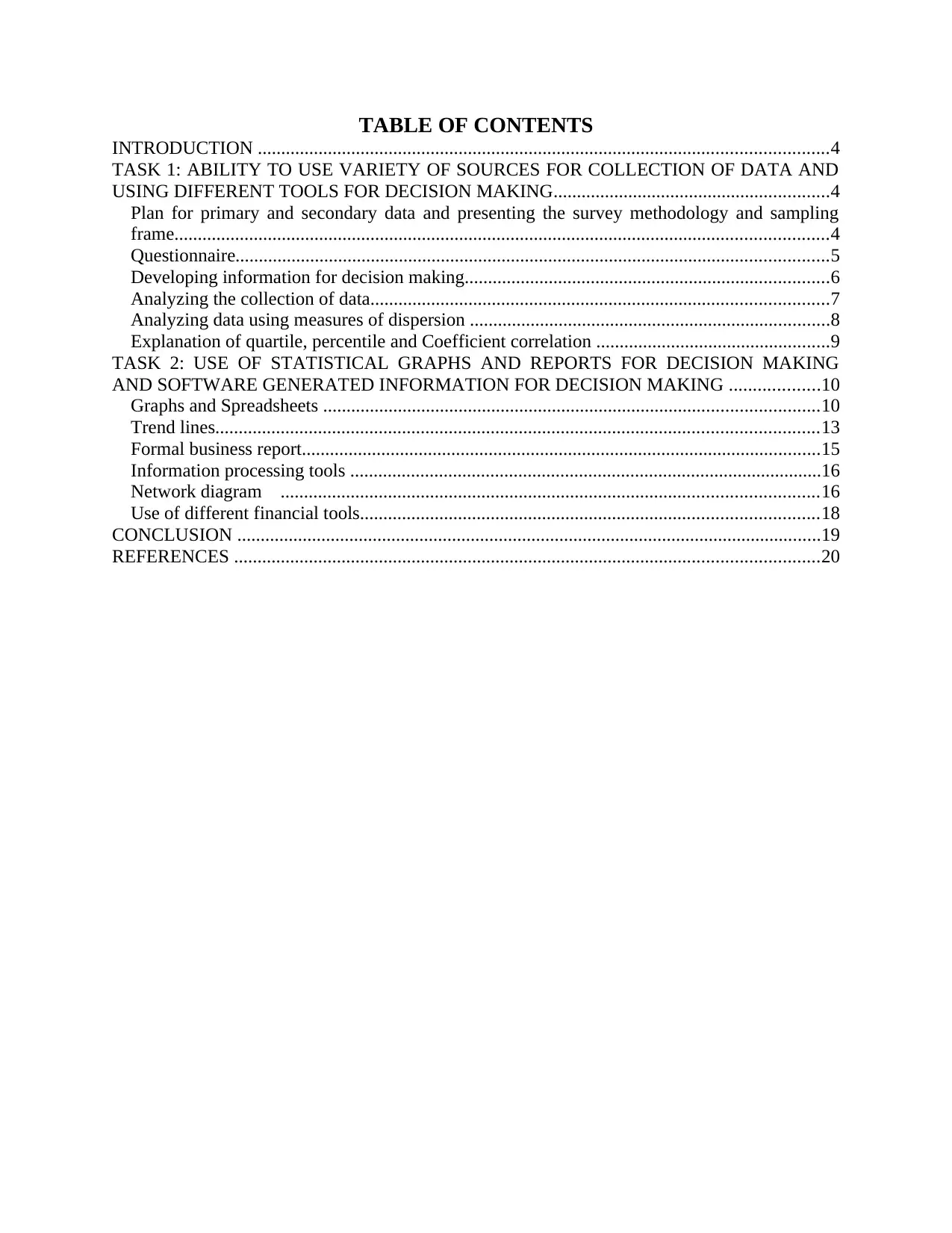
TABLE OF CONTENTS
INTRODUCTION ..........................................................................................................................4
TASK 1: ABILITY TO USE VARIETY OF SOURCES FOR COLLECTION OF DATA AND
USING DIFFERENT TOOLS FOR DECISION MAKING...........................................................4
Plan for primary and secondary data and presenting the survey methodology and sampling
frame............................................................................................................................................4
Questionnaire...............................................................................................................................5
Developing information for decision making..............................................................................6
Analyzing the collection of data..................................................................................................7
Analyzing data using measures of dispersion .............................................................................8
Explanation of quartile, percentile and Coefficient correlation ..................................................9
TASK 2: USE OF STATISTICAL GRAPHS AND REPORTS FOR DECISION MAKING
AND SOFTWARE GENERATED INFORMATION FOR DECISION MAKING ...................10
Graphs and Spreadsheets ..........................................................................................................10
Trend lines.................................................................................................................................13
Formal business report...............................................................................................................15
Information processing tools .....................................................................................................16
Network diagram ...................................................................................................................16
Use of different financial tools..................................................................................................18
CONCLUSION .............................................................................................................................19
REFERENCES .............................................................................................................................20
INTRODUCTION ..........................................................................................................................4
TASK 1: ABILITY TO USE VARIETY OF SOURCES FOR COLLECTION OF DATA AND
USING DIFFERENT TOOLS FOR DECISION MAKING...........................................................4
Plan for primary and secondary data and presenting the survey methodology and sampling
frame............................................................................................................................................4
Questionnaire...............................................................................................................................5
Developing information for decision making..............................................................................6
Analyzing the collection of data..................................................................................................7
Analyzing data using measures of dispersion .............................................................................8
Explanation of quartile, percentile and Coefficient correlation ..................................................9
TASK 2: USE OF STATISTICAL GRAPHS AND REPORTS FOR DECISION MAKING
AND SOFTWARE GENERATED INFORMATION FOR DECISION MAKING ...................10
Graphs and Spreadsheets ..........................................................................................................10
Trend lines.................................................................................................................................13
Formal business report...............................................................................................................15
Information processing tools .....................................................................................................16
Network diagram ...................................................................................................................16
Use of different financial tools..................................................................................................18
CONCLUSION .............................................................................................................................19
REFERENCES .............................................................................................................................20

⊘ This is a preview!⊘
Do you want full access?
Subscribe today to unlock all pages.

Trusted by 1+ million students worldwide

4
Paraphrase This Document
Need a fresh take? Get an instant paraphrase of this document with our AI Paraphraser
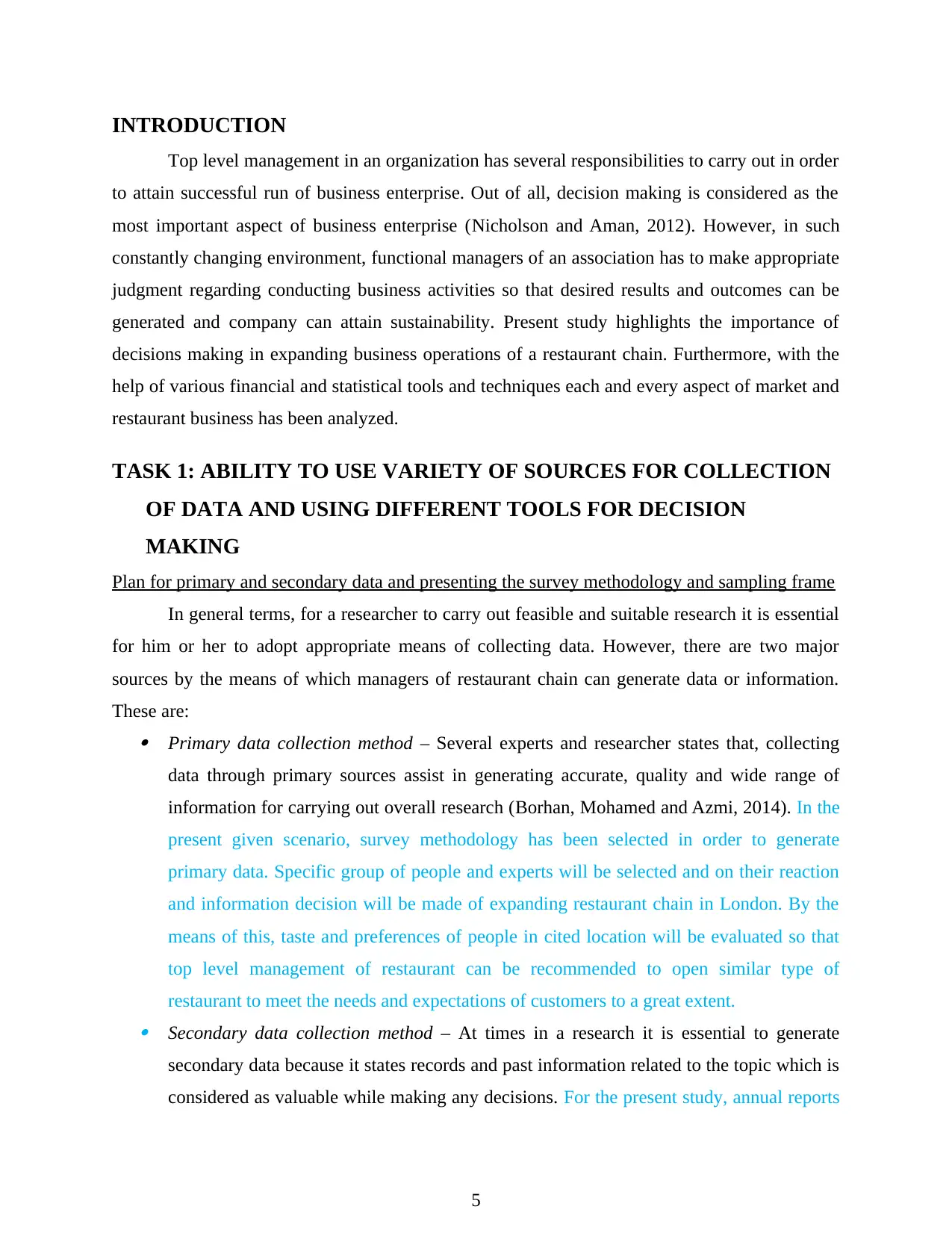
INTRODUCTION
Top level management in an organization has several responsibilities to carry out in order
to attain successful run of business enterprise. Out of all, decision making is considered as the
most important aspect of business enterprise (Nicholson and Aman, 2012). However, in such
constantly changing environment, functional managers of an association has to make appropriate
judgment regarding conducting business activities so that desired results and outcomes can be
generated and company can attain sustainability. Present study highlights the importance of
decisions making in expanding business operations of a restaurant chain. Furthermore, with the
help of various financial and statistical tools and techniques each and every aspect of market and
restaurant business has been analyzed.
TASK 1: ABILITY TO USE VARIETY OF SOURCES FOR COLLECTION
OF DATA AND USING DIFFERENT TOOLS FOR DECISION
MAKING
Plan for primary and secondary data and presenting the survey methodology and sampling frame
In general terms, for a researcher to carry out feasible and suitable research it is essential
for him or her to adopt appropriate means of collecting data. However, there are two major
sources by the means of which managers of restaurant chain can generate data or information.
These are: Primary data collection method – Several experts and researcher states that, collecting
data through primary sources assist in generating accurate, quality and wide range of
information for carrying out overall research (Borhan, Mohamed and Azmi, 2014). In the
present given scenario, survey methodology has been selected in order to generate
primary data. Specific group of people and experts will be selected and on their reaction
and information decision will be made of expanding restaurant chain in London. By the
means of this, taste and preferences of people in cited location will be evaluated so that
top level management of restaurant can be recommended to open similar type of
restaurant to meet the needs and expectations of customers to a great extent. Secondary data collection method – At times in a research it is essential to generate
secondary data because it states records and past information related to the topic which is
considered as valuable while making any decisions. For the present study, annual reports
5
Top level management in an organization has several responsibilities to carry out in order
to attain successful run of business enterprise. Out of all, decision making is considered as the
most important aspect of business enterprise (Nicholson and Aman, 2012). However, in such
constantly changing environment, functional managers of an association has to make appropriate
judgment regarding conducting business activities so that desired results and outcomes can be
generated and company can attain sustainability. Present study highlights the importance of
decisions making in expanding business operations of a restaurant chain. Furthermore, with the
help of various financial and statistical tools and techniques each and every aspect of market and
restaurant business has been analyzed.
TASK 1: ABILITY TO USE VARIETY OF SOURCES FOR COLLECTION
OF DATA AND USING DIFFERENT TOOLS FOR DECISION
MAKING
Plan for primary and secondary data and presenting the survey methodology and sampling frame
In general terms, for a researcher to carry out feasible and suitable research it is essential
for him or her to adopt appropriate means of collecting data. However, there are two major
sources by the means of which managers of restaurant chain can generate data or information.
These are: Primary data collection method – Several experts and researcher states that, collecting
data through primary sources assist in generating accurate, quality and wide range of
information for carrying out overall research (Borhan, Mohamed and Azmi, 2014). In the
present given scenario, survey methodology has been selected in order to generate
primary data. Specific group of people and experts will be selected and on their reaction
and information decision will be made of expanding restaurant chain in London. By the
means of this, taste and preferences of people in cited location will be evaluated so that
top level management of restaurant can be recommended to open similar type of
restaurant to meet the needs and expectations of customers to a great extent. Secondary data collection method – At times in a research it is essential to generate
secondary data because it states records and past information related to the topic which is
considered as valuable while making any decisions. For the present study, annual reports
5
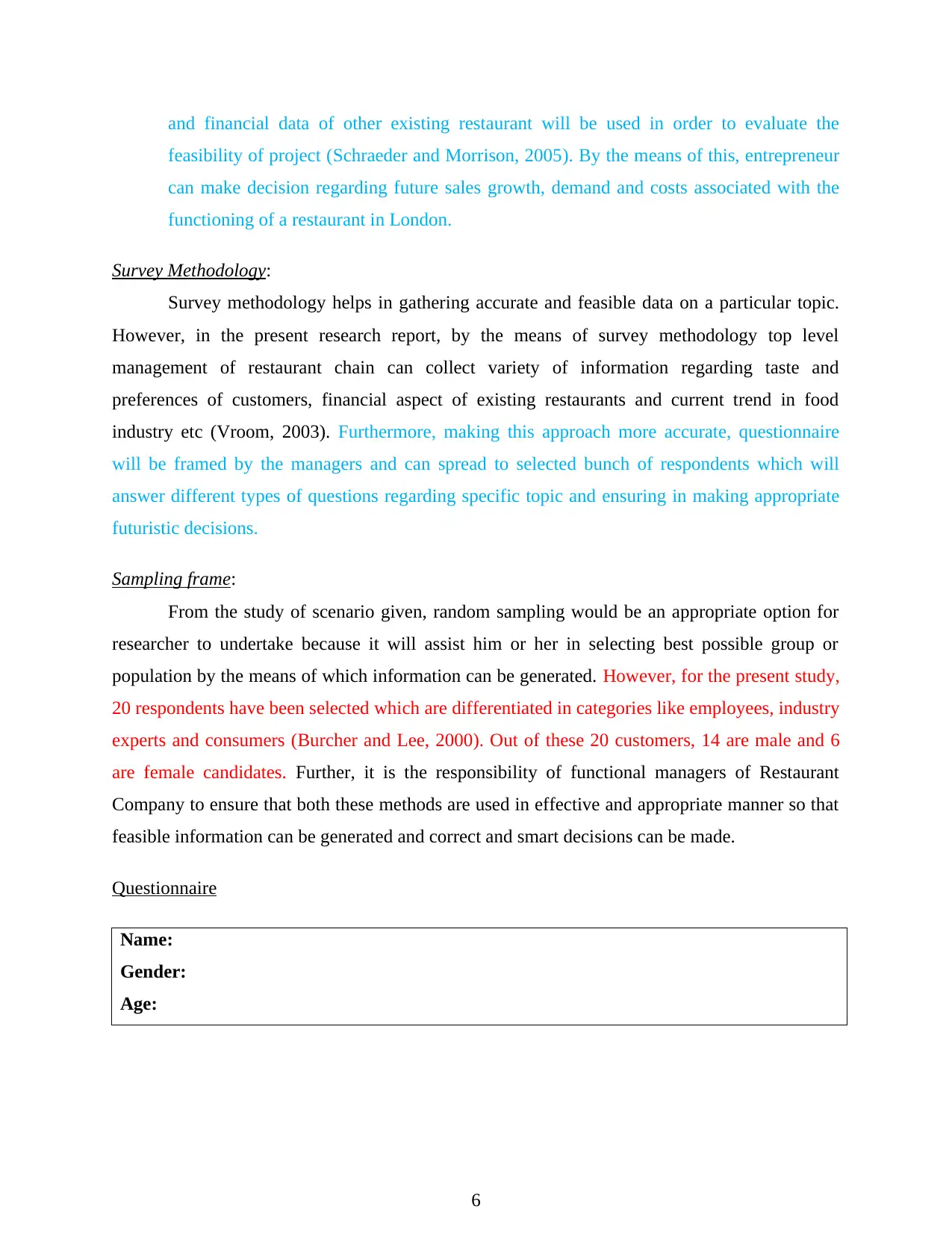
and financial data of other existing restaurant will be used in order to evaluate the
feasibility of project (Schraeder and Morrison, 2005). By the means of this, entrepreneur
can make decision regarding future sales growth, demand and costs associated with the
functioning of a restaurant in London.
Survey Methodology:
Survey methodology helps in gathering accurate and feasible data on a particular topic.
However, in the present research report, by the means of survey methodology top level
management of restaurant chain can collect variety of information regarding taste and
preferences of customers, financial aspect of existing restaurants and current trend in food
industry etc (Vroom, 2003). Furthermore, making this approach more accurate, questionnaire
will be framed by the managers and can spread to selected bunch of respondents which will
answer different types of questions regarding specific topic and ensuring in making appropriate
futuristic decisions.
Sampling frame:
From the study of scenario given, random sampling would be an appropriate option for
researcher to undertake because it will assist him or her in selecting best possible group or
population by the means of which information can be generated. However, for the present study,
20 respondents have been selected which are differentiated in categories like employees, industry
experts and consumers (Burcher and Lee, 2000). Out of these 20 customers, 14 are male and 6
are female candidates. Further, it is the responsibility of functional managers of Restaurant
Company to ensure that both these methods are used in effective and appropriate manner so that
feasible information can be generated and correct and smart decisions can be made.
Questionnaire
Name:
Gender:
Age:
6
feasibility of project (Schraeder and Morrison, 2005). By the means of this, entrepreneur
can make decision regarding future sales growth, demand and costs associated with the
functioning of a restaurant in London.
Survey Methodology:
Survey methodology helps in gathering accurate and feasible data on a particular topic.
However, in the present research report, by the means of survey methodology top level
management of restaurant chain can collect variety of information regarding taste and
preferences of customers, financial aspect of existing restaurants and current trend in food
industry etc (Vroom, 2003). Furthermore, making this approach more accurate, questionnaire
will be framed by the managers and can spread to selected bunch of respondents which will
answer different types of questions regarding specific topic and ensuring in making appropriate
futuristic decisions.
Sampling frame:
From the study of scenario given, random sampling would be an appropriate option for
researcher to undertake because it will assist him or her in selecting best possible group or
population by the means of which information can be generated. However, for the present study,
20 respondents have been selected which are differentiated in categories like employees, industry
experts and consumers (Burcher and Lee, 2000). Out of these 20 customers, 14 are male and 6
are female candidates. Further, it is the responsibility of functional managers of Restaurant
Company to ensure that both these methods are used in effective and appropriate manner so that
feasible information can be generated and correct and smart decisions can be made.
Questionnaire
Name:
Gender:
Age:
6
⊘ This is a preview!⊘
Do you want full access?
Subscribe today to unlock all pages.

Trusted by 1+ million students worldwide
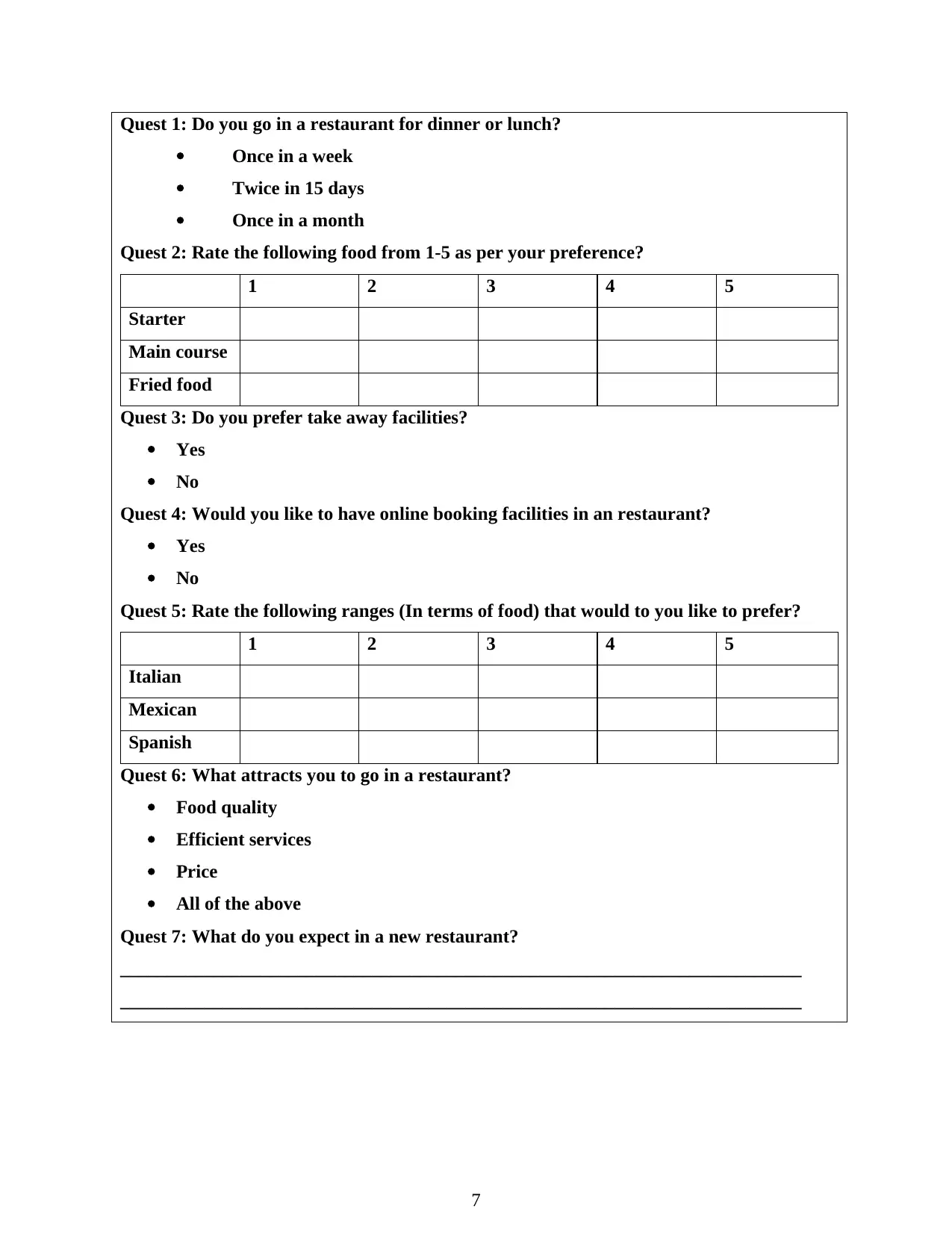
Quest 1: Do you go in a restaurant for dinner or lunch?
Once in a week
Twice in 15 days
Once in a month
Quest 2: Rate the following food from 1-5 as per your preference?
1 2 3 4 5
Starter
Main course
Fried food
Quest 3: Do you prefer take away facilities?
Yes
No
Quest 4: Would you like to have online booking facilities in an restaurant?
Yes
No
Quest 5: Rate the following ranges (In terms of food) that would to you like to prefer?
1 2 3 4 5
Italian
Mexican
Spanish
Quest 6: What attracts you to go in a restaurant?
Food quality
Efficient services
Price
All of the above
Quest 7: What do you expect in a new restaurant?
_________________________________________________________________________
_________________________________________________________________________
7
Once in a week
Twice in 15 days
Once in a month
Quest 2: Rate the following food from 1-5 as per your preference?
1 2 3 4 5
Starter
Main course
Fried food
Quest 3: Do you prefer take away facilities?
Yes
No
Quest 4: Would you like to have online booking facilities in an restaurant?
Yes
No
Quest 5: Rate the following ranges (In terms of food) that would to you like to prefer?
1 2 3 4 5
Italian
Mexican
Spanish
Quest 6: What attracts you to go in a restaurant?
Food quality
Efficient services
Price
All of the above
Quest 7: What do you expect in a new restaurant?
_________________________________________________________________________
_________________________________________________________________________
7
Paraphrase This Document
Need a fresh take? Get an instant paraphrase of this document with our AI Paraphraser
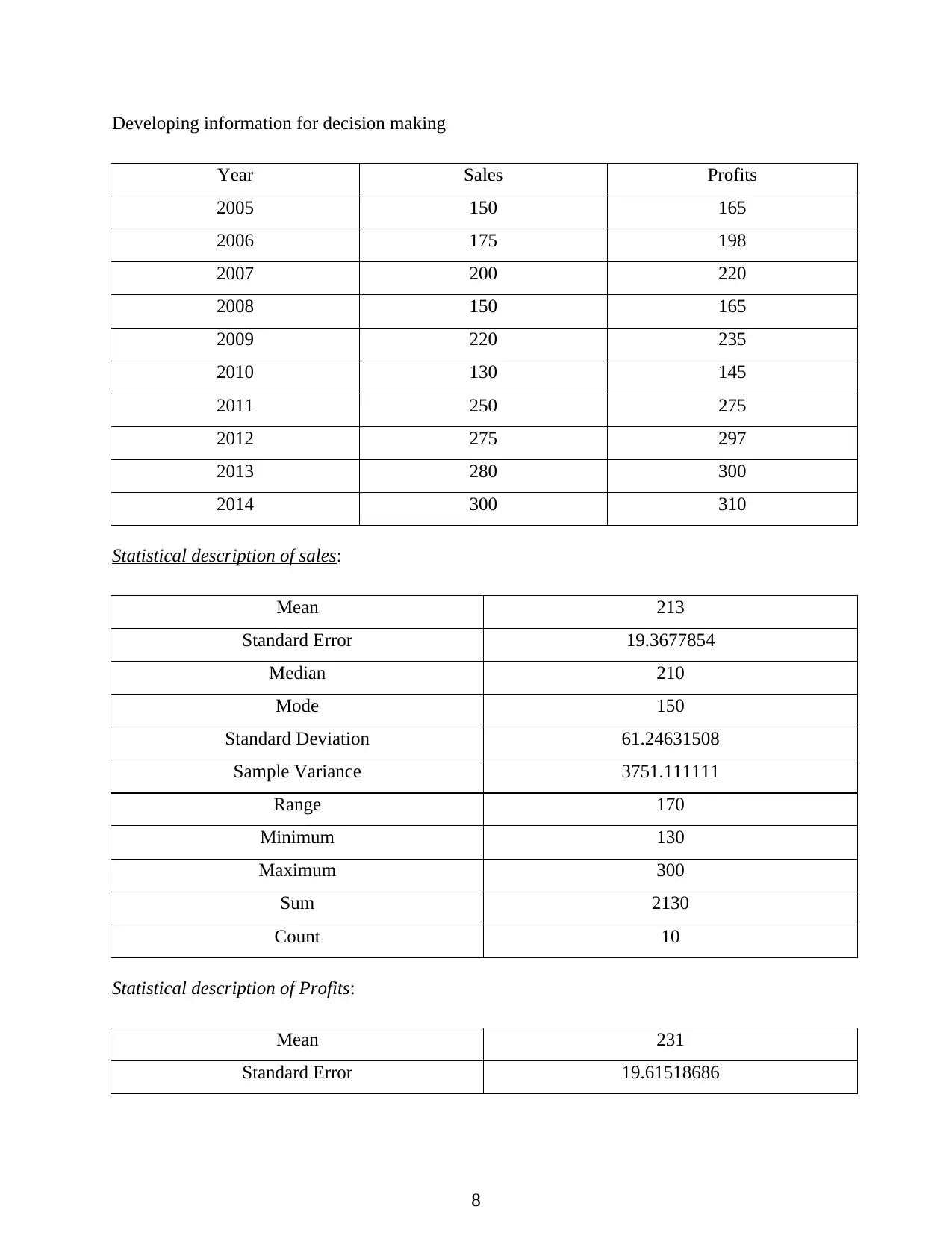
Developing information for decision making
Year Sales Profits
2005 150 165
2006 175 198
2007 200 220
2008 150 165
2009 220 235
2010 130 145
2011 250 275
2012 275 297
2013 280 300
2014 300 310
Statistical description of sales:
Mean 213
Standard Error 19.3677854
Median 210
Mode 150
Standard Deviation 61.24631508
Sample Variance 3751.111111
Range 170
Minimum 130
Maximum 300
Sum 2130
Count 10
Statistical description of Profits:
Mean 231
Standard Error 19.61518686
8
Year Sales Profits
2005 150 165
2006 175 198
2007 200 220
2008 150 165
2009 220 235
2010 130 145
2011 250 275
2012 275 297
2013 280 300
2014 300 310
Statistical description of sales:
Mean 213
Standard Error 19.3677854
Median 210
Mode 150
Standard Deviation 61.24631508
Sample Variance 3751.111111
Range 170
Minimum 130
Maximum 300
Sum 2130
Count 10
Statistical description of Profits:
Mean 231
Standard Error 19.61518686
8
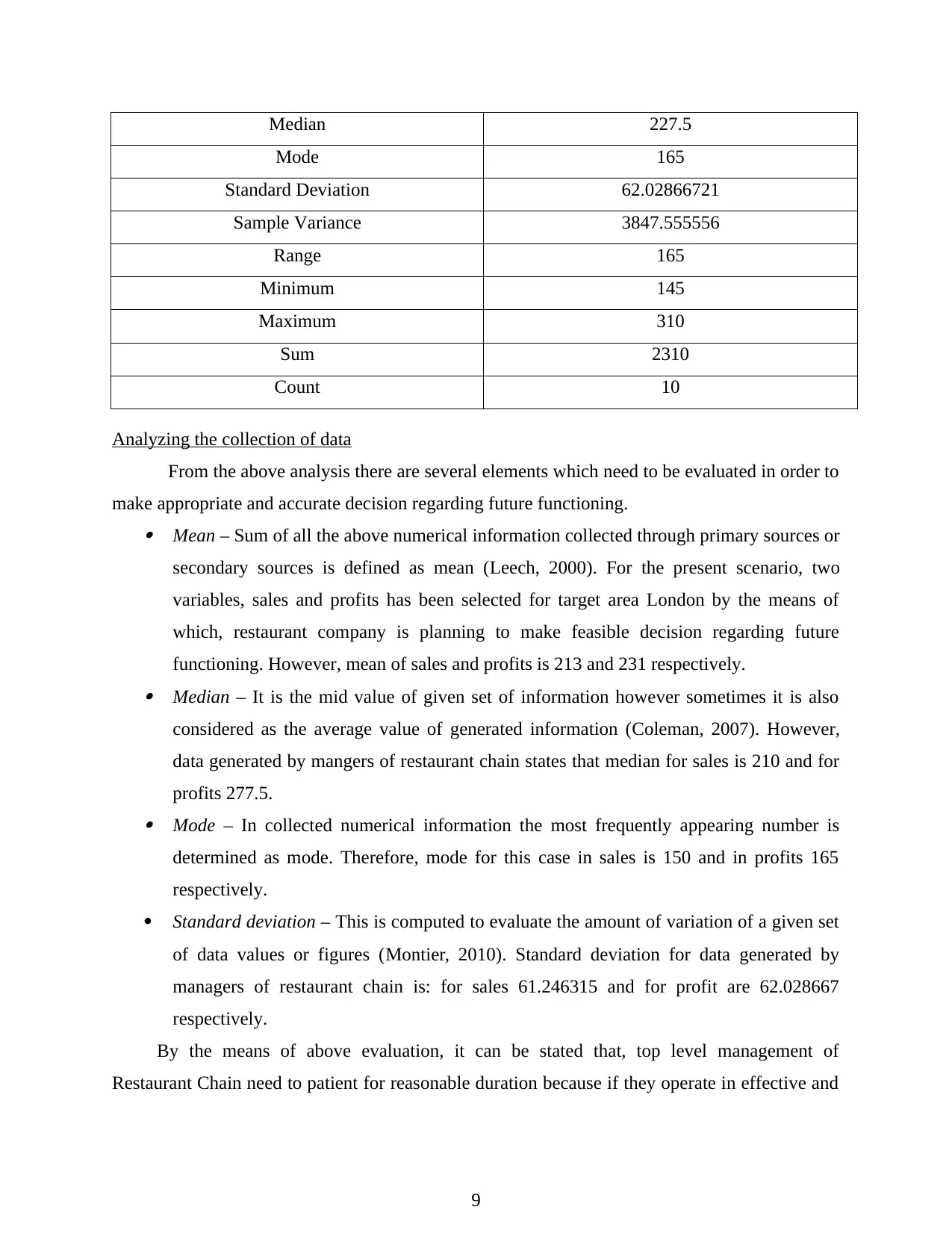
Median 227.5
Mode 165
Standard Deviation 62.02866721
Sample Variance 3847.555556
Range 165
Minimum 145
Maximum 310
Sum 2310
Count 10
Analyzing the collection of data
From the above analysis there are several elements which need to be evaluated in order to
make appropriate and accurate decision regarding future functioning. Mean – Sum of all the above numerical information collected through primary sources or
secondary sources is defined as mean (Leech, 2000). For the present scenario, two
variables, sales and profits has been selected for target area London by the means of
which, restaurant company is planning to make feasible decision regarding future
functioning. However, mean of sales and profits is 213 and 231 respectively. Median – It is the mid value of given set of information however sometimes it is also
considered as the average value of generated information (Coleman, 2007). However,
data generated by mangers of restaurant chain states that median for sales is 210 and for
profits 277.5. Mode – In collected numerical information the most frequently appearing number is
determined as mode. Therefore, mode for this case in sales is 150 and in profits 165
respectively.
Standard deviation – This is computed to evaluate the amount of variation of a given set
of data values or figures (Montier, 2010). Standard deviation for data generated by
managers of restaurant chain is: for sales 61.246315 and for profit are 62.028667
respectively.
By the means of above evaluation, it can be stated that, top level management of
Restaurant Chain need to patient for reasonable duration because if they operate in effective and
9
Mode 165
Standard Deviation 62.02866721
Sample Variance 3847.555556
Range 165
Minimum 145
Maximum 310
Sum 2310
Count 10
Analyzing the collection of data
From the above analysis there are several elements which need to be evaluated in order to
make appropriate and accurate decision regarding future functioning. Mean – Sum of all the above numerical information collected through primary sources or
secondary sources is defined as mean (Leech, 2000). For the present scenario, two
variables, sales and profits has been selected for target area London by the means of
which, restaurant company is planning to make feasible decision regarding future
functioning. However, mean of sales and profits is 213 and 231 respectively. Median – It is the mid value of given set of information however sometimes it is also
considered as the average value of generated information (Coleman, 2007). However,
data generated by mangers of restaurant chain states that median for sales is 210 and for
profits 277.5. Mode – In collected numerical information the most frequently appearing number is
determined as mode. Therefore, mode for this case in sales is 150 and in profits 165
respectively.
Standard deviation – This is computed to evaluate the amount of variation of a given set
of data values or figures (Montier, 2010). Standard deviation for data generated by
managers of restaurant chain is: for sales 61.246315 and for profit are 62.028667
respectively.
By the means of above evaluation, it can be stated that, top level management of
Restaurant Chain need to patient for reasonable duration because if they operate in effective and
9
⊘ This is a preview!⊘
Do you want full access?
Subscribe today to unlock all pages.

Trusted by 1+ million students worldwide
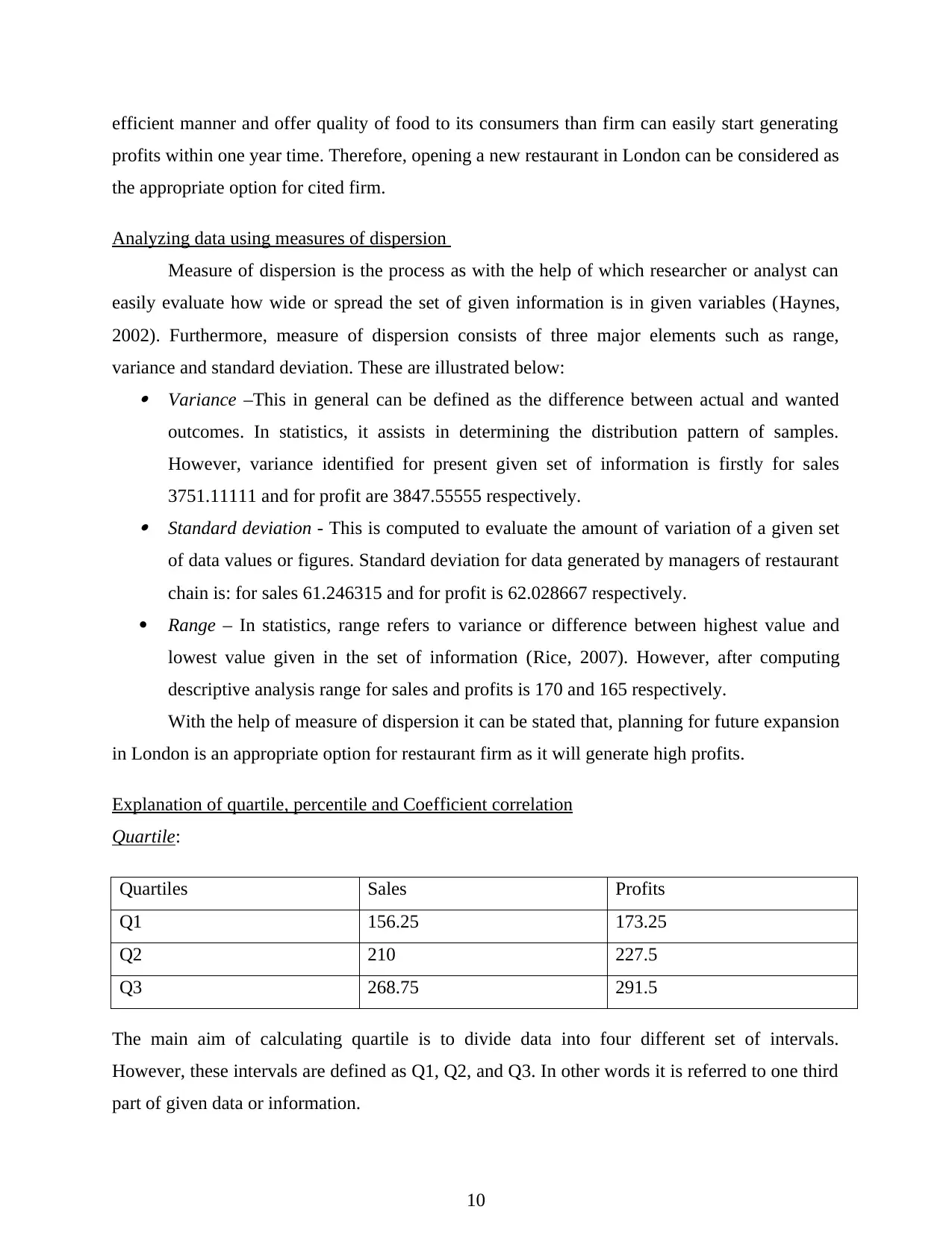
efficient manner and offer quality of food to its consumers than firm can easily start generating
profits within one year time. Therefore, opening a new restaurant in London can be considered as
the appropriate option for cited firm.
Analyzing data using measures of dispersion
Measure of dispersion is the process as with the help of which researcher or analyst can
easily evaluate how wide or spread the set of given information is in given variables (Haynes,
2002). Furthermore, measure of dispersion consists of three major elements such as range,
variance and standard deviation. These are illustrated below: Variance –This in general can be defined as the difference between actual and wanted
outcomes. In statistics, it assists in determining the distribution pattern of samples.
However, variance identified for present given set of information is firstly for sales
3751.11111 and for profit are 3847.55555 respectively. Standard deviation - This is computed to evaluate the amount of variation of a given set
of data values or figures. Standard deviation for data generated by managers of restaurant
chain is: for sales 61.246315 and for profit is 62.028667 respectively.
Range – In statistics, range refers to variance or difference between highest value and
lowest value given in the set of information (Rice, 2007). However, after computing
descriptive analysis range for sales and profits is 170 and 165 respectively.
With the help of measure of dispersion it can be stated that, planning for future expansion
in London is an appropriate option for restaurant firm as it will generate high profits.
Explanation of quartile, percentile and Coefficient correlation
Quartile:
Quartiles Sales Profits
Q1 156.25 173.25
Q2 210 227.5
Q3 268.75 291.5
The main aim of calculating quartile is to divide data into four different set of intervals.
However, these intervals are defined as Q1, Q2, and Q3. In other words it is referred to one third
part of given data or information.
10
profits within one year time. Therefore, opening a new restaurant in London can be considered as
the appropriate option for cited firm.
Analyzing data using measures of dispersion
Measure of dispersion is the process as with the help of which researcher or analyst can
easily evaluate how wide or spread the set of given information is in given variables (Haynes,
2002). Furthermore, measure of dispersion consists of three major elements such as range,
variance and standard deviation. These are illustrated below: Variance –This in general can be defined as the difference between actual and wanted
outcomes. In statistics, it assists in determining the distribution pattern of samples.
However, variance identified for present given set of information is firstly for sales
3751.11111 and for profit are 3847.55555 respectively. Standard deviation - This is computed to evaluate the amount of variation of a given set
of data values or figures. Standard deviation for data generated by managers of restaurant
chain is: for sales 61.246315 and for profit is 62.028667 respectively.
Range – In statistics, range refers to variance or difference between highest value and
lowest value given in the set of information (Rice, 2007). However, after computing
descriptive analysis range for sales and profits is 170 and 165 respectively.
With the help of measure of dispersion it can be stated that, planning for future expansion
in London is an appropriate option for restaurant firm as it will generate high profits.
Explanation of quartile, percentile and Coefficient correlation
Quartile:
Quartiles Sales Profits
Q1 156.25 173.25
Q2 210 227.5
Q3 268.75 291.5
The main aim of calculating quartile is to divide data into four different set of intervals.
However, these intervals are defined as Q1, Q2, and Q3. In other words it is referred to one third
part of given data or information.
10
Paraphrase This Document
Need a fresh take? Get an instant paraphrase of this document with our AI Paraphraser
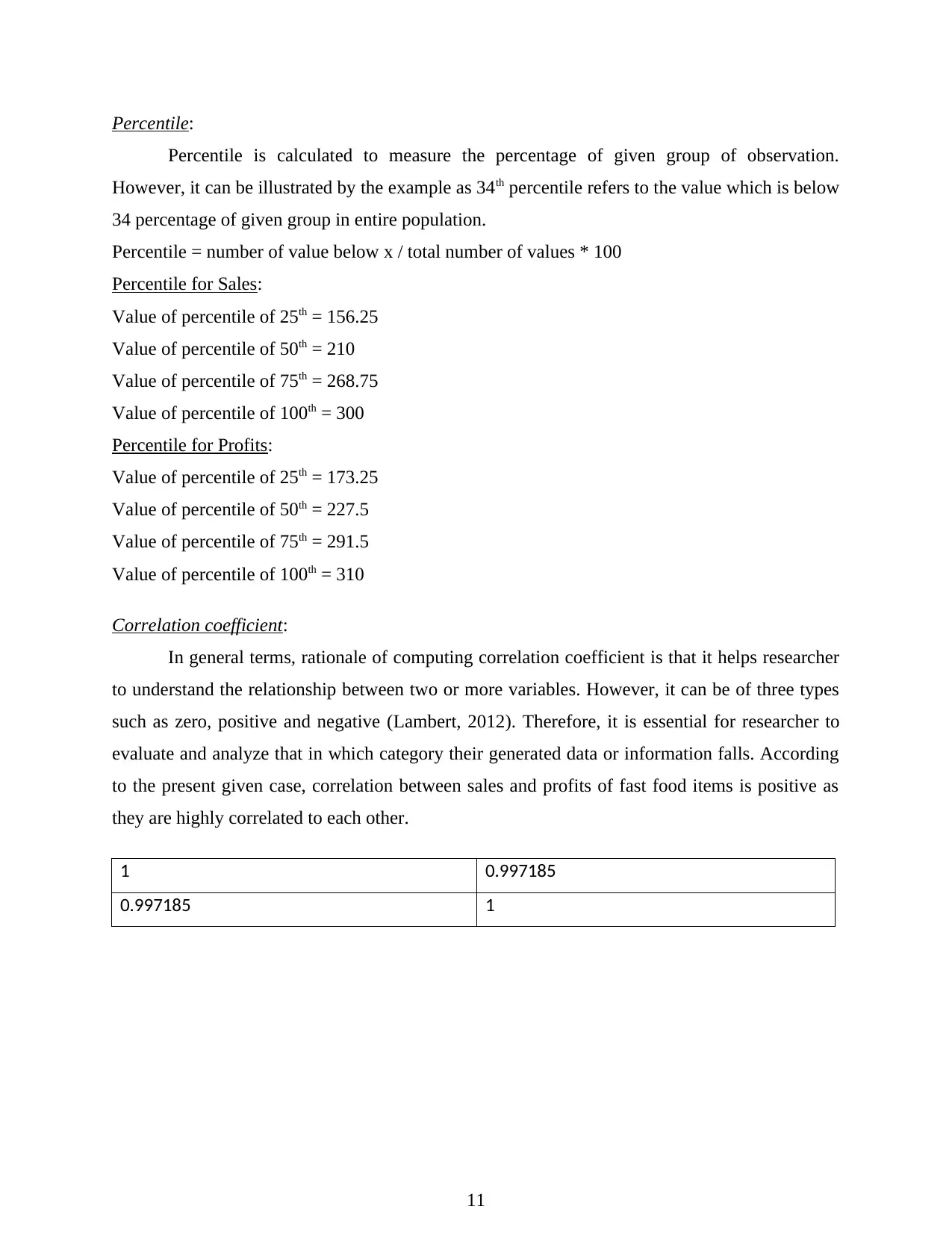
Percentile:
Percentile is calculated to measure the percentage of given group of observation.
However, it can be illustrated by the example as 34th percentile refers to the value which is below
34 percentage of given group in entire population.
Percentile = number of value below x / total number of values * 100
Percentile for Sales:
Value of percentile of 25th = 156.25
Value of percentile of 50th = 210
Value of percentile of 75th = 268.75
Value of percentile of 100th = 300
Percentile for Profits:
Value of percentile of 25th = 173.25
Value of percentile of 50th = 227.5
Value of percentile of 75th = 291.5
Value of percentile of 100th = 310
Correlation coefficient:
In general terms, rationale of computing correlation coefficient is that it helps researcher
to understand the relationship between two or more variables. However, it can be of three types
such as zero, positive and negative (Lambert, 2012). Therefore, it is essential for researcher to
evaluate and analyze that in which category their generated data or information falls. According
to the present given case, correlation between sales and profits of fast food items is positive as
they are highly correlated to each other.
1 0.997185
0.997185 1
11
Percentile is calculated to measure the percentage of given group of observation.
However, it can be illustrated by the example as 34th percentile refers to the value which is below
34 percentage of given group in entire population.
Percentile = number of value below x / total number of values * 100
Percentile for Sales:
Value of percentile of 25th = 156.25
Value of percentile of 50th = 210
Value of percentile of 75th = 268.75
Value of percentile of 100th = 300
Percentile for Profits:
Value of percentile of 25th = 173.25
Value of percentile of 50th = 227.5
Value of percentile of 75th = 291.5
Value of percentile of 100th = 310
Correlation coefficient:
In general terms, rationale of computing correlation coefficient is that it helps researcher
to understand the relationship between two or more variables. However, it can be of three types
such as zero, positive and negative (Lambert, 2012). Therefore, it is essential for researcher to
evaluate and analyze that in which category their generated data or information falls. According
to the present given case, correlation between sales and profits of fast food items is positive as
they are highly correlated to each other.
1 0.997185
0.997185 1
11
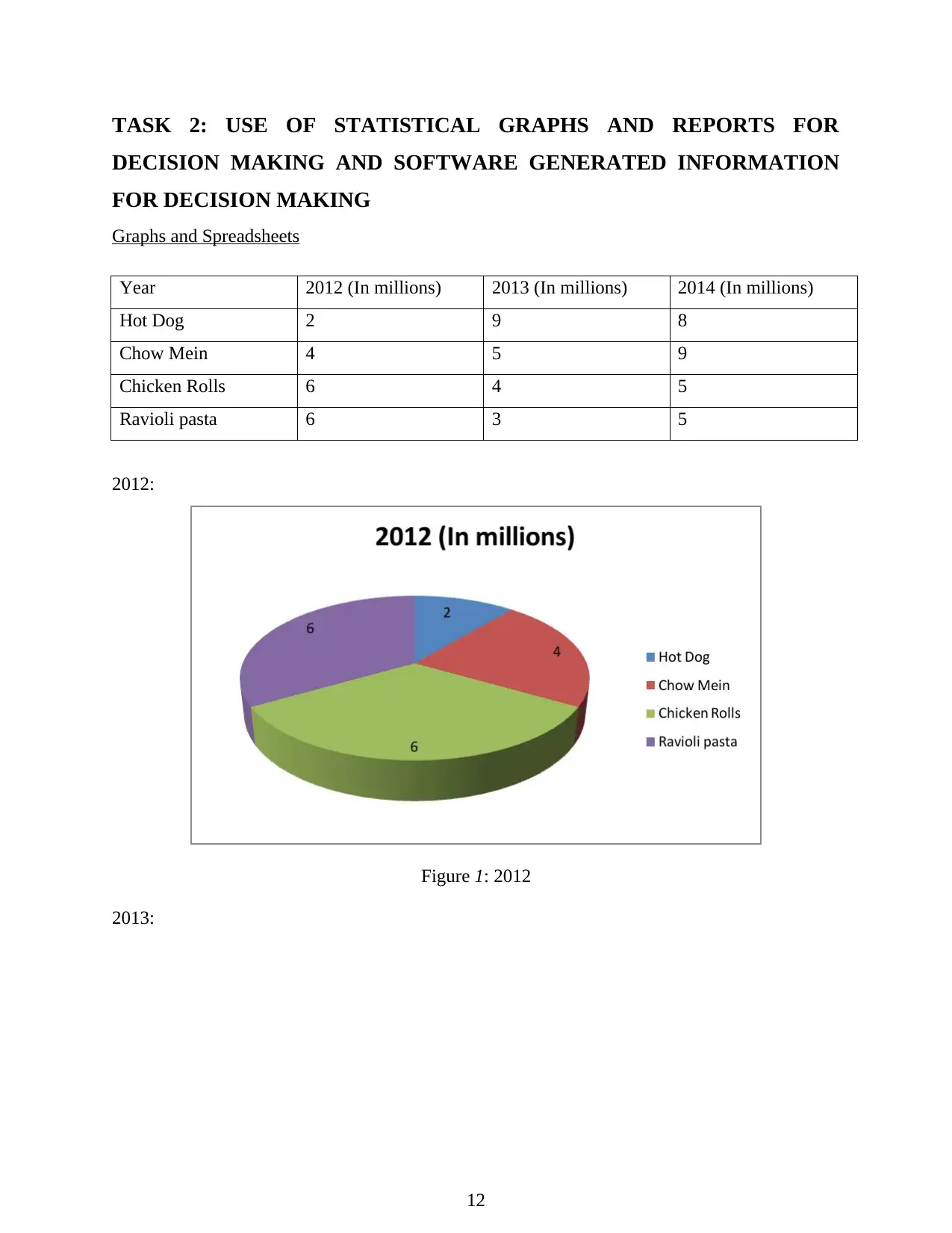
TASK 2: USE OF STATISTICAL GRAPHS AND REPORTS FOR
DECISION MAKING AND SOFTWARE GENERATED INFORMATION
FOR DECISION MAKING
Graphs and Spreadsheets
Year 2012 (In millions) 2013 (In millions) 2014 (In millions)
Hot Dog 2 9 8
Chow Mein 4 5 9
Chicken Rolls 6 4 5
Ravioli pasta 6 3 5
2012:
Figure 1: 2012
2013:
12
DECISION MAKING AND SOFTWARE GENERATED INFORMATION
FOR DECISION MAKING
Graphs and Spreadsheets
Year 2012 (In millions) 2013 (In millions) 2014 (In millions)
Hot Dog 2 9 8
Chow Mein 4 5 9
Chicken Rolls 6 4 5
Ravioli pasta 6 3 5
2012:
Figure 1: 2012
2013:
12
⊘ This is a preview!⊘
Do you want full access?
Subscribe today to unlock all pages.

Trusted by 1+ million students worldwide
1 out of 24
Related Documents
Your All-in-One AI-Powered Toolkit for Academic Success.
+13062052269
info@desklib.com
Available 24*7 on WhatsApp / Email
![[object Object]](/_next/static/media/star-bottom.7253800d.svg)
Unlock your academic potential
Copyright © 2020–2025 A2Z Services. All Rights Reserved. Developed and managed by ZUCOL.





